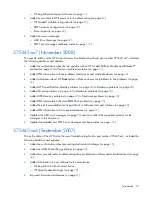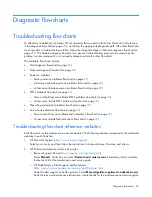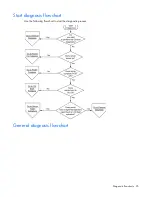
Getting started 17
Performing processor procedures in the troubleshooting process
Because this document supports multiple generations of HP ProLiant server models, it also covers processes
that include troubleshooting of various models and types of processors.
Before performing any troubleshooting steps that involve processors, review the following guidelines:
•
Be sure that only authorized personnel perform the troubleshooting steps that involve installation,
removal, or replacement of a processor.
•
Always locate the documentation for your processor model before performing
any
steps that require
installing, removing, or replacing a processor. If you cannot locate the hard copy of the instructions,
locate your server user guide or maintenance and service guide on the HP website
(
http://www.hp.com/support/manuals
).
•
Some processor models require the use of a processor installation tool, and specific steps are
documented to ensure that you do not damage the processor or processor socket on the system board.
For server models that have pins inside the processor socket, remember that
THE PINS ON THE SYSTEM
BOARD ARE VERY FRAGILE AND EASILY DAMAGED
. If you damage the socket, you must replace the
system board.
•
Depending on the server model, the contacts may be on the processor or they may be inside the
processor socket. Never touch the contacts.
THE PINS ON THE SYSTEM BOARD ARE VERY FRAGILE AND
EASILY DAMAGED
. If the contacts inside the processor socket are damaged, you must replace the
system board.
•
Always complete all other troubleshooting procedures before removing or replacing a processor.
Breaking the server down to the minimum hardware configuration
During the troubleshooting process, you may be asked to break the server down to the minimum hardware
configuration. A minimum configuration consists of only the components needed to boot the server and
successfully pass POST.
When requested to break the server down to the minimum configuration, uninstall the following components,
if installed:
•
All additional DIMMs
Leave only the minimum required to boot the server—either one DIMM or a pair of DIMMs. For more
information, see the memory guidelines in the server user guide.
•
All additional cooling fans, if applicable
For the minimum fan configuration, see the server user guide.
•
All additional power supplies, if applicable (leave one installed)
•
All hard drives
•
All optical drives (DVD-ROM, CD-ROM, and so forth)
•
All optional mezzanine cards
•
All expansion boards
Before removing the components, be sure to determine the minimum configuration for each component and
follow all guidelines in the server user guide.
















































